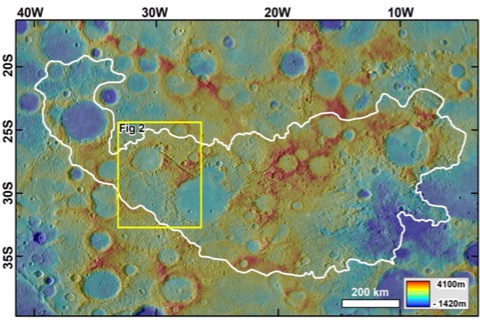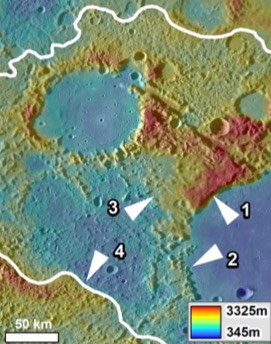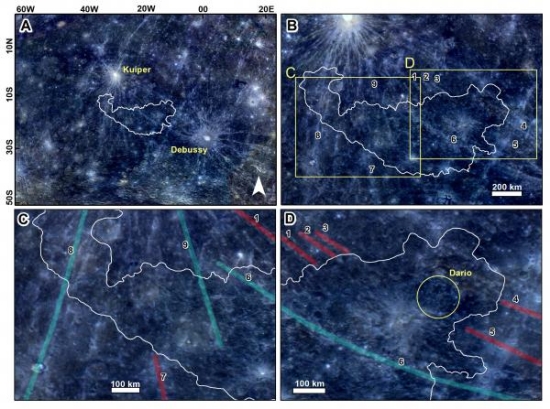Centauri Dreams rarely looks at Mercury, the operative method being generally to focus on the outer Solar System and beyond. But a new paper out of the Planetary Science Institute in Tucson (AZ) raises the eyebrows in suggesting that parts of Mercury may once have been able to shelter prebiotic chemistry and perhaps, according to the authors, even primitive life forms. Such a finding might thus extend our ideas of ‘habitable zones’ much closer to parent stars than previously assumed.
It seems a long shot, given surface temperatures reaching 430? in the daytime and -180? at night, but the PSI work turns up interesting possibilities in some subsurface regions of Mercury. The heart of this research is found in the datasets returned by the MESSENGER (MErcury Surface Space ENvironment GEochemistry and Ranging) spacecraft. The Mercury orbiter identified numerous volatile-bearing surfaces on Mercury, with high abundances of sulfur, chlorine and potassium, and polar ice in permanently shadowed craters at the planet’s poles.
Key to the research are Mercury’s ‘chaotic’ terrains, hilly and fractured areas first seen in 1974 in the flybys of Mariner 10. The planet’s spectacular Caloris Basin is a crater about 1525 kilometers across ringed by mile-high mountains. Interestingly, numerous chaotic terrains are found directly on the other side of the planet from the Caloris Basin, leading to the theory that the impact produced them. The new paper finds that idea unconvincing. Instead, the chaotic terrains seem to have formed through gradual developments of a non-catastrophic nature. From the paper:
We attribute the immense volume losses, which we infer to have occurred during chaotic terrain formation… to widespread collapse associated with the devolatilization of hundreds of meters to a few kilometers of upper crustal materials. In the context of this hypothesis, we define “collapse” as encompassing elevation losses due to (1) mass wasting associated with the sublimation of surface/near-surface volatiles and (2) gravity-driven terrain disintegration over zones of deep volatile evacuation.

Image: Extent of a vast chaotic terrain (white outline) at the antipode of the Caloris basin (~5 x 105 km2). Credit: Rodriguez et al.
In other words, no impact needed. The authors note that the chaotic terrain is not geographically limited to the Caloris antipode, suggesting that the volatile-rich crust may have been global. They also find that the antipodal area experienced an active phase about 1.8 billion years ago for reasons unknown. The paper identifies large areas of surface elevation losses within the antipodal chaotic terrains, a finding the authors interpret as the result of crustal volatiles turning into gas and escaping from Mercury’s upper crust over an area of about 500,000 square kilometers.

Daniel Berman (Planetary Science Institute) is a co-author of the paper:
“The deep valleys and enormous mountains that now characterize the chaotic terrains were once part of volatile-rich geologic deposits a few kilometers deep, and do not consist of ancient cratered surfaces that were seismically disturbed due to the formation of Mercury’s Caloris impact basin on the opposite side of the planet, as some scientists had speculated. A key to the discovery was the finding that the development of the chaotic terrains persisted until approximately 1.8 billion years ago, 2 billion years after the Caloris basin formed.”
Image: Zoom in showing variable magnitudes of collapse, which includes a relatively unmodified rim section that is smooth but not broken into knobs (arrow 1). This area adjoins another part of the rim that has been almost entirely removed (arrow 2). The adjacent intercrater regions also exhibit deep and abrupt relief losses (arrows 3 & 4). Credit: Rodriguez et al.
Where did this volatile-rich crust come from? One possibility is impacts from outer Solar System objects or perhaps main belt asteroids. Another is outgassing of volatiles from the interior. PSI’s Jeff Kargel, likewise a co-author, makes this interesting point:
“We also observe evidence of surficial devolatilization, probably caused by solar heating. If so, we have an opportunity to infer the range of Mercury’s volatile properties and compositions… While not all volatiles make for habitability, water ice can if temperatures are right. Some of Mercury’s other volatiles may have added to the characteristics of a former aqueous niche. Even if habitable conditions existed only briefly, relics of prebiotic chemistry or rudimentary life still might exist in the chaotic terrains.”

Image: Context view showing the location and extent of the chaotic terrain antipodal to the Caloris basin (outlined in white) relative to the ray systems of the Kuiper and Debussy impact craters. (B) Close-up view of panel A that provides the context and locations for panels C and D. The numbers 1-9 identify individual rays within the region’s view. (C, D) Close-up view showing crater rays that extend over the chaotic terrain (green lines 6, 8, 9) and other crater rays that appear truncated over the chaotic terrain (red lines 1-5, 7). We provide the location of the hollow hosting crater Dario in panel C. Credit: Rodriguez et al.
That volatile losses may not all be ancient is inferred from the fact that crater ejecta rays are not found in extensive areas of the chaotic terrain, which the authors interpret as indicating more recent activity. Mercury’s ‘hollows’ — small depressions resembling melt pits in terrestrial permafrost — have likewise been investigated as signs of near-surface volatile losses, although the matter is still under investigation. Whatever the case, it’s apparent that MESSENGER has returned enough information to offer up a first round of potential landing sites to investigate the planet’s volatile-rich crust and conceivably study its unexplored potential for astrobiology.
The paper is Rodriguez et al., “The Chaotic Terrains of Mercury Reveal a History of Planetary Volatile Retention and Loss in the Innermost Solar System,” Scientific Reports 10, Article number: 4737 (2020). Full text.



A perfectly fine paper that the authors felt a need to “sex up” with this last:
Maybe it is the zeitgeist. Nasa started the “follow the water” meme that meant that suddenly Europa and Enceladus with subsurface oceans might be living. Astronomers defining the habitable zone where liquid water could exist on the planetary surface, with the result that every exoplanet that appeared to be rocky was suddenly a possible living world, and illustrators depicted these planets as ambiguously living.
Water is a necessary, but insufficient condition for life, as any sterile bottle of distilled water shows. As we do not know the conditions for abiogenesis, we, therefore, do not know what the sufficient conditions are. As a result, some people pin their hopes on panspermia. (Mea culpa, I have been guilty of that myself.)
By making this last statement, the authors are effectively suggesting that it just be worth sending a probe with a lander to have a look, perhaps with life-detection instruments like the ExoMars 2020 (now 2022) rover. They are certainly drawing attention to their paper.
There may need to be some expectations management soon. If Mars proves lifeless, and do the icy moons, it will be up to the astronomers to demonstrate unambiguous biosignatures on some exoplanets. Without this, the pendulum may swing all the way back to the idea that Earth is unique and the only living world. That might just benefit how we treat our planet although I suspect that rather it will just push the idea of terraforming, Mars first, then ultimately the galaxy and the universe.
In the meantime, it would be good if authors refrained from using the word “habitable” (and therefore with it the associated baggage and perceptions) and use less loaded language.
In the courses of their respective activities, scientists–like lawyers–use many words, including commonly-used, everyday ones–in senses that differ from the commonly-understood meanings of those words, and I think “habitable” is an example of this. (“Metallicity” is another example; to astronomers, a star’s metallicity refers to its relative abundances of all elements heavier than hydrogen and helium, whether or not those heavier elements are, in fact, actually metals [this term may have arisen because the next two elements after helium–lithium and beryllium–are metals].) Also:
With regard to hypothetical Hermian (Mercurian) life, I think they mean “habitable” in a similarly broad sense. Volatiles-containing surface and/or subsurface areas of Mercury (portions of the ice-containing, permanently-shadowed polar craters and valleys might also be included, where indirect, reflected sunlight could create clement micro-environments) would be habitable for some hardy terrestrial microbes. They would also be habitable for any indigenous Hermian ones–if such there be–that utilize chemosynthesis or photosynthesis (or conceivably even *both*, in different species of Hermian organisms–or possibly even in the ^same^ species, as Willy Ley discussed with regard to lunar plant life in his 1964 book “Missiles, Moonprobes, and Megaparsecs”), and:
“Habitability” could also–particularly where Mercury and Venus are involved–have a temporal element. Long ago, the Sun was considerably less luminous than it now is, and back then Mercury (and Venus) were less intensely heated. If life arose on either or both of these planets way back then, it could have adapted to the slowly-changing conditions as the Sun brightened. As well:
I also mention Venus because even today, there are terrestrial microbes (which Arthur C. Clarke mentioned in his non-fiction 1968 book “The Promise of Space”) which have partly replaced the carbon in their DNA with sulfur, and can live happily in boiling sulfuric acid, so they would thrive in Venus’ sun-drenched sulfuric acid clouds. (Today, some biologists suspect that a “shadow biosphere” of arsenic-based microbes may exist on Earth; Paul Davies discussed this in his 2010 book “The Eerie Silence: Searching for Ourselves in the Universe.) It is quite possible that we may find microbial life in all sorts of unlikely-seeming places in our Solar System, from Mercury to our Moon to Mars to Ceres to the Galilean moons to Enceladus, and if so, a further question–which chirality tests could answer–would then need to be asked: Did those life forms arise there, or are they distant cousins of Earth microbes, “kidnapped” and then deposited there by ejecta from large meteoroid or asteroid impacts on our planet?
The water ice was found with radar near the poles of Mercury on the night side. The Caloris Basin volatiles came from it’s interior. The plans of the Caloris basin composed of basalt which came from impact melt or vents and fissures.
The Messenger data show the abundances of the volatiles sulfur, sodium, potassium, calcium, aluminum, chlorine. The gamma ray neutron spectrometer has found some oxygen. There is not an abundance of oxygen and no hydrogen so where is the evidence for water there?
While we often do wild speculations during coffee breaks, the authors have put such onto an actual paper.
That Mercury have had a brief period with volatiles on the surface have been assumed for a long time.
The sun did shine less strongly during the Archean, and that match roughly with the 2 billion years they seem to think that smaller craters were eroded. That there have been some geological activity is beyond doubt. We see one of the lines even in the figures of this article, I wonder if they think that is karst? In 2 billion years, yes there might have been time to see prokaryotic life. Perhaps even transported with meteorites between the planets. I wonder what kind of remnants they seem to suggest might be find, microbial mats of such age are natural choice.
Thanks Paul
Another interesting article and I’m glad you took a look at Mercury, its one interesting place for a number of reasons.
Here was an interesting article I was also reading
http://spaceref.com/mercury/mercurys-400-c-heat-may-help-it-make-its-own-ice.html
The occurrence of cometary debris left from when comets pass to close to the sun could be an explanation for this. The orbit of Mercury and higher speed of its orbit would seem to mean that volatiles left from comet remnants should be more common. Mercury being only on average 36 million miles from the sun, is in the zone where comets expel huge amounts of material and break apart into smaller pieces. This would also replenish the water at the poles and may be able to sustain a primitive ecosystem.
Hydroxl OH is formed only in an environment which already has water and low temperatures or an atmosphere of oxygen interacting with water molecules, but not in the Caloris Basin on Mercury which contain a basalt rich in plagioclase feldspar or potassium and aluminum etc. and high temperatures and no hydrogen and little oxygen.
This type of data tends to support the possibility of a human presence on Mercury. The planet is about as close as Mars, same gravity, a little less escape velocity, a bit more delta vee. Getting there would be an impressive exercise in radiation shielding, but once sheltered in a shadowed crater the humans should have some natural protection. There is water there, and this study prospects some other important elements. This paper’s progress toward understanding the geology of the planet should increase the chance of extracting trace elements like nitrogen or maybe argon for breathing mixtures that would be essential for a prolonged human presence.
A principal advantage of Mercury would be the unlimited free energy – solar power nine times more concentrated than that of Earth, which could be concentrated with flimsy mirrors built to withstand only low gravity and no wind. Without air, rocks can be melted and metals can be refined out in the open, and finished ingots can be sent to Earth by railgun. Lengthy night-time expeditions can be made, though one would hate to have car trouble. It seems easy to imagine a team of geologists camped there both for abstract study and to support practical mining operations, taking their recreation by a pleasant forest lake beneath a robust dome of locally produced leaded glass, sunning themselves by the light of a tall reflective boom that projects beyond the permanently shadowed crater. It is also useful to study any possibility of a local biology, to rule out the risk of an unanticipated plague and to stop up any ecological complaints about the mining operations.
I love Mercury for science fiction, but the real-world problem with Mercury as a destination for human settlement is that it is inconveniently hard to get to.
It’s deep down the solar gravity well– when your transfer orbit gets you there, the delta-V to stop is very high. And there’s no atmosphere to do aerobraking or aerocapture; you really have to do propulsive delta-V.
There’s a reason that there have been so few Mercury missions.
Hmmm… A runway would be exciting, but you run out of ground to put it on. A space elevator would be nice, but first you have to spin up the planet. Using a cargo railgun backward would pancake a human crew, or require an absurd number of needle-threadings from some implausible orbit. How about a copula drive? Set up a mining infrastructure that fires ingots back to Earth every hour and pays the bills for the initial robot landings. The colony ship is a railgun that can push against the ingots as they pass through it. Hopefully there is a plan so that the ingots will not hit anything too interesting if coupling is aborted. Alright, I have no idea how to calculate the feasibility of this one (how well can the path in and out be aligned?), but what could possibly go wrong? :)
Need we assume that Mercury has always been where it is? (Nice model; Grand tack model).
The year-round average temperature on Mercury is below the boiling point everywhere, and above freezing except at high latitudes. The daily/seasonal variation in temperature should smooth out at several tens of meters below the surface, so the near-subsurface would theoretically remain habitable if any of theoretical life evolved on Mercury.
There is a problem that most water in the upper near-surface would have sublimated away. At high latitudes, however, an ice layer in the subsurface would protect liquid water being heated from Mercury’s internal warmth from sublimating. At all latitudes, there may be a sub-surface layer that is above the level of internal heat that is sterilizing, but also sufficiently deep that water can’t escape via sublimation.
So if life evolved there, or was transferred there via a meteor impact that injected living microorganisms deep enough into the subsurface, it might still be there.
Getting evidence is another matter though. It will be a long time before we send a lander with the capacity to drill hundreds of meters down. Before that, maybe a capable rover will be able to explore craters that excavated deeply and look for preserved evidence of life.
The surface temperature on the daylight side of Mercury reaches 800 F., and is everywhere on its daylight side, the temperature is above the melting temperature of lead. There is no spectroscopic evidence of water, hydrogen or oxygen on the daylight side so it certainly would have to be underground. Even if there were Hydroxl OH on Mercury, the surface heat is not hot enough to break their molecular bonds. Cosmic rays would break their bonds, but there would have to be some OH there.